The primary function of a gasket is to prevent leaks between the mating parts. Compression of the gasket is necessary to create a barrier to form a pressure-tight seal and prevent the internal fluids from escaping.
The moving parts of a mechanical system are protected by a gasket, which prevents them from rubbing against hard surfaces and creating friction.
Let’s learn more about types of gaskets and their applications in this article
What is Gasket?
A gasket is a sealing device, made from a deformable material. It separates fluids, gases, and contaminants by sandwiching them between two stationary components.
A gasket’s seal can withstand high pressures, temperature swings, and electromagnetic forces. Unlike the components they join, gaskets can conform to the surfaces’ shape.
How To Choose A Gasket?
- The gasket material must be pliable enough to compress into the flange’s imperfections.
- Stress and temperature should not cause the gaskets to deform. Lower bolt tensions and potential leakage could ensue.
- There should be no emissions or leakage if the gasket is tight enough
- The gasket should be able to withstand both static and dynamic stress, temperature, and pressure changes.
- The pressure inside the gasket must not cause it to burst; otherwise, it will leak.
- Without polluting media, it must be immune to chemical attacks.
- When the flange is opened, the gasket should be able to come loose from the flange with ease.
- High-temperature sealing should be possible with the gasket.
- It must be as rigid as possible to facilitate the installation process.
Types of Gaskets
Gaskets can be classified as follows based on a variety of factors.
A. Types of Gaskets Based on Gasket Material
- Metallic gaskets
- Non Metallic Gaskets
- Semi-Metallic Gaskets
B. Types of Gaskets Based on Configuration
- Spiral-wound Gasket
- Kammprofile Gasket
- Ring-Joint Gasket
- Fishbone Gasket
- Constant Seating Stress Gaskets
- Double Jacketed Gaskets
- Flange Gasket
C. Types Of Gaskets Based On Manufacturing Process
- Die Cut Gaskets
- Molded Gaskets
- Extruded Gaskets
- Form-in-place Gaskets and Cured-in-place Gaskets
Metallic Gaskets
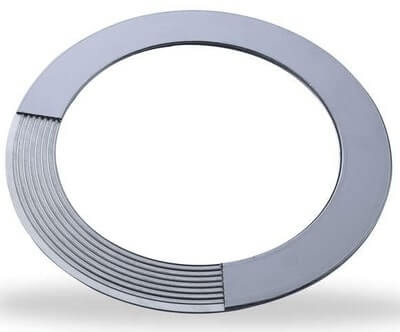
Metal gaskets are best suited for use in situations involving extremely high pressures. When the flush connection surfaces come into contact, they either make an initial line contact or contain the fluid by wedging.
This type of metal gasket is also known as a “ring” gasket, and it can be made in either an octagonal or ovular shape.
In the face of high pressures, such as 20,000 psi, the BX type of octagonal cross sections provides great strength. A high-tension bolting system is commonly used to secure metal gaskets in the oil and gas industry to secure metal gaskets.
Metal gaskets can be made from various materials, including High-carbon steel, Inconel, Stainless steel, and Monel.
Non-Metallic Gaskets
It is possible to squeeze a non-metallic or soft gasket between two surfaces with little tension or pressure. It is the best option for your application if you’re looking for a gasket that won’t leak under low-pressure conditions.
Because soft gaskets are inexpensive, they can be used in low-temperature applications without sacrificing performance.
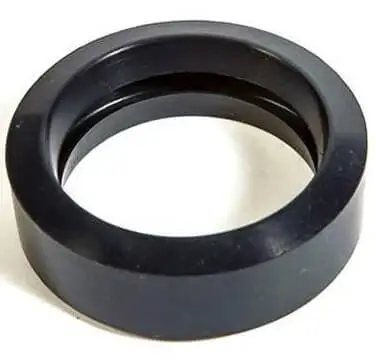
Graphite, a common non-metallic material, can be used in high-temperature applications up to 500°C. Full-face gaskets are used for temporary connections, while inside bolt circle gaskets cover a smaller area of the connecting surface; these gaskets are commonly used to connect utility lines, among other things.
Non-metal gaskets can be made from various materials, including Compressed Non-Asbestos Fiber (CNAF), Graphite, Polytetrafluoroethylene (PTFE), Rubber, and Teflon.
Composite Gaskets or Semi-Metallic Gaskets
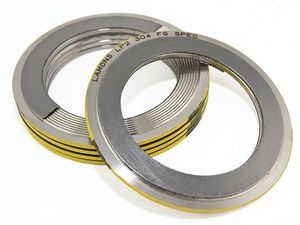
They are made of a mixture of metal and non-metal components. While the metal portion of a gasket is designed to provide structural integrity, the non-metallic portion is designed to provide flexibility and seal ability.
Spiral wound, metal jacketed, Cam profile, and various metal-reinforced graphite gaskets are among the most commonly used semi-metallic gaskets. Semi-metallic gaskets are made to withstand a wider range of temperatures and pressures than any other type.
Spiral wound Gasket
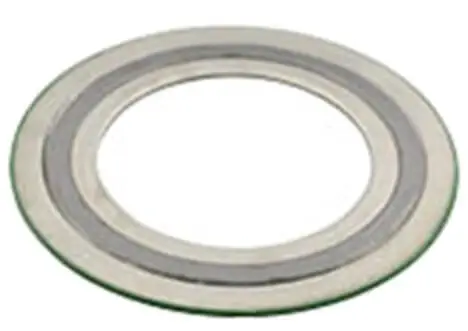
A spiral wound gasket is a semi-metallic gasket made of metallic and non-metallic components coiled around each other. Strength and resilience are provided by metal, whereas non-metallic materials provide seal ability and conformability.
Because a spiral wound gasket is constructed in the shape of an aluminum ring with a flexible filler material in the middle, the sealing property is maintained in any scenario.
Most typically, stainless steel is utilized as a filler material in spiral-wrapped gaskets, while graphite or asbestos are employed as filler materials in the same way. This gasket is intended for use in environments with high temperatures and pressures.
Kammprofile Gasket
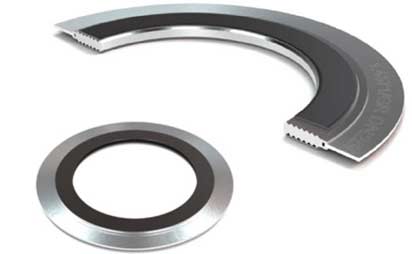
Gaskets with a metal core attached to a soft filler material on both sides are known as Kammprofile gaskets. The soft non-metallic filler is put into the metal core serrated grooves once the Kammprofile gasket has been installed.
Gasket makers use an appropriate sealing material to cover kamm profile gaskets to prevent the flange from being damaged during operations.
Non-metallic fillers such as graphite or PTFE are commonly utilized in composite gaskets. The price of these gaskets may be a little higher than that of other types of gaskets. However, in terms of offering value, they are more affordable.
Ring-Joint Gasket
The heavy-duty, high-pressure Ring-Type joint metal gaskets (also known as RTJ gaskets or API joint gaskets) are used in high-integrity pressure vessel joints, the offshore and onshore petrochemical sector, and oil-field drilling and completion equipment, valves, and pipework assemblies.
They can withstand pressures of 1,000 to 15,000 pounds per square inch. A modest bolt load is required for these gaskets to provide high gasket pressure.
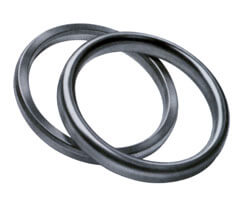
Oval and octagonal ring-joint gaskets are the most commonly utilized. The curved surface of oval gaskets contacts the flange face and ensures a strong seal. It makes it more difficult to get precise measurements and finish the surface.
Fishbone Gasket

There is no better option for high-temperature and high-pressure sealing than the fishbone gasket. Gaskets are critical to the safety of a plant.
This is especially true in the oil and gas sector, chemical plants, paper mills, and power plants, all of which move a lot of fluid around.
As a result, pipelines transport volatile chemicals and high-pressure steam through millions of connections, including valve seats, heat exchanger flanges, and reactor covers.
Constant Seating Stress Gaskets

The constant seating stress gasket comprises a stainless steel carrier ring and two sealing elements made of a compressible material installed in two channels on either side of the carrier ring and one channel on either side ring.
As sealing elements, expanded graphite expanded PTFE, vermiculite, and other materials are employed.
Double Jacketed Gaskets

This type of gasket is made up of a metallic tube with a wide C-shaped profile and a second metal piece that bridges the opening of this C-shape, with filler material filling the inside space.
The C-closest profile’s edges have a double thickness thanks to the overlap of the outer shell and the gap-bridging cover piece. To ensure a tight seal, the thicker section of the gasket takes the brunt of the pressure.
Flange Gasket
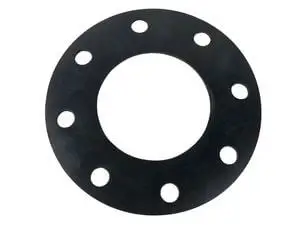
It is a type of gasket designed to fit between two sections of pipe flared to provide more surface area for the gasket. The inside and outside diameters are used to classify the various sizes available.
Traditional ring gaskets and full-face gaskets are considered inferior. The use of pipe flange gaskets is common in water and sewer systems, but they are especially beneficial in high-pressure applications, such as flanged piping with extremely large diameters.
Die Cut Gaskets:
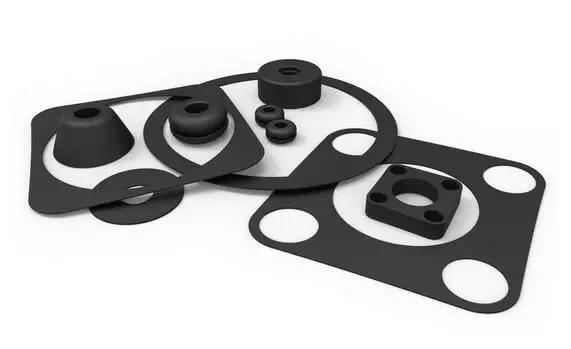
Die-cut gaskets are used to seal two surfaces together. A die-cut gasket seals the gap between the surfaces when enough bolt load is applied. Because it fills in any blemishes on the mating surfaces, a seal helps to eliminate design defects and application mistakes.
Molded Gaskets:
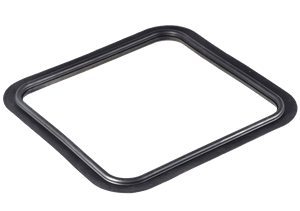
There are many advantages to using molding to produce gaskets in large quantities. Liquid rubber is poured into a mold and allowed to cool to the desired shape before the mold and press are removed to create rubber gaskets. Increased precision and lower unit costs are two benefits of this manufacturing method.
Extruded Gaskets

These gaskets are inexpensive and can be made from silicon and rubber in various shapes and sizes. Extruded gaskets are cut to a specific length and inserted into a part’s groove for use in various applications.
Foamed In Gasket
Electronic Coating Technologies provides form-in-place (FIP) and cured-in-place (CIP) gasket services. The gaskets are applied as a liquid, gel, or paste using automated four-axis dispensing equipment that ensures appropriate bead diameters even on complex geometries.
A rubbery or foam gasket is formed by heating, drying, or curing the material under high-intensity UV/Visible light. Regarding fillers, there is a vast range of options available.

Application of Gaskets
- Gasket used in transporting materials.
- Gaskets are commonly used in the construction of homes and other structures.
- Stainless steel gaskets are used automotive industry.
- SS gaskets are used in sewerage systems and industrial water lines.
- It is used in heating and air-conditioning equipment.
- Gaskets are also used in plumbing work.
- Rubber gaskets used in the paper and pulp manufacturing process
- Ring Type Joint Gaskets used in the Food Industry
Conclusion: Types Of Gaskets
When used as mechanical seals, gaskets prevent process fluids from leaking or contaminants from entering the sensitive areas of the machine.
Selecting the proper gasket for each system is critical because there is a best-suited gasket for every circumstance. It’s important to strike a balance when making a gasket selection.